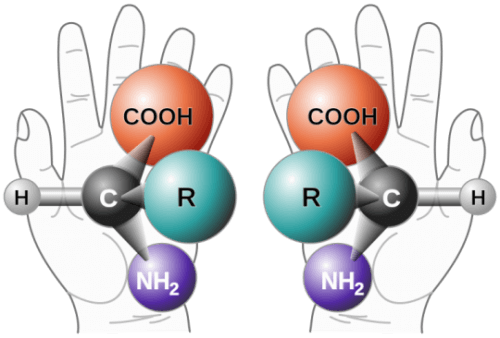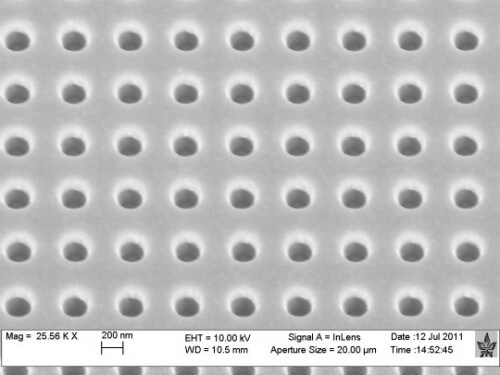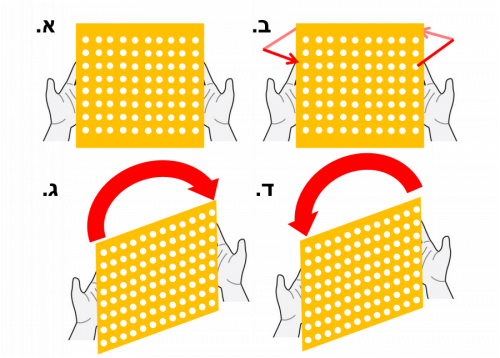I met with Ben Maoz to ask him what they are doing there at the university.
Ben is a PhD student in physical chemistry in the group of Prof. Gil Markowitz from Tel Aviv University. He is married to Yasmin, who is engaged in research in physics as part of a post-doctorate at the Weizmann Institute, and together they are the parents of a child. On weekends, Ben usually participates in a dirt bike riding group that started as a small hobby and over time became a big and fun hobby.
Ben, so what are you doing there?
Our lab deals with a variety of topics related to special materials and nanotechnology, but I would like to tell you mainly about a very special project we have been working on. The goal of the project is to develop a new way to produce materials with a negative refractive index, using plasmons and the chirality feature (don't worry, we'll explain soon).
What is refractive index and why all this negativity?
When light passes between a medium, for example between air and glass, some of it is reflected and some is refracted. The angle of refraction depends on a property of the two materials called the 'refractive index' and is the ratio between the speed of light in a vacuum and the speed of light in the material. The possible refraction angles are limited because the refraction coefficients are always positive (see Figure 1).

A few years ago scientists showed theoretically and then also experimentally that with the help of materials with a negative refractive index it is possible to develop a device that hides things from the eye (let's say the maiden's cloak). They achieved the negative refractive index by using metamaterials which are man-made structures made up of small and special units. The most common way to obtain a negative refractive index is by creating the structure from tiny electrical circuit units (half the wavelength) like an antenna. The special structure allows metamaterials to affect light in ways that no natural material can. The main problems with this direction are engineering problems that make it very difficult to create the appropriate materials.
There is, in our opinion, a simpler way to create materials with a negative refractive index by using metals with chiral properties.
What is chirality?
The word chirality comes from the Greek word for hands. We will notice that although our hands are similar, they are actually a mirror image of each other. I am sure that anyone who has tried to put a right hand glove on the left hand or vice versa has noticed this. Imagine meeting a friend and extending your right hand to shake his hand. If the friend gets confused and sends you his left hand, you will have a lot of difficulty in the pressing action, which may lead to a moment of embarrassment.

In nature, there are molecules that can equally have a right-handed and a left-handed configuration (see Figure 2). Since many molecules have an effect in our body, and the effect of the right hand and the left hand may be different, the issue of chirality is very important to us. For example, a certain molecule in the right hand configuration is sugar and in the left hand configuration it is an artificial sweetener. And in the field of medicine, a molecule that in one direction is used to treat cough and in the other direction to relieve pain.
As a side note, one of the biggest mysteries in science today is why all the sugars and proteins in the body of any living creature are all created with the same chirality, meaning that they are either all right-handed or all left-handed.
Another property of chirality is its effect on polarized light. Polarization is the direction of the electric field fluctuations in relation to the direction of the light wave, therefore polarized light is an electromagnetic wave with a definite polarization (as opposed to, for example, sunlight which consists of a collection of waves with different polarizations). When polarized light passes through a solution of chiral molecules, the polarization angle will change according to the direction of chirality, if right-handed then in one direction and if left-handed then in the opposite direction.
So how does all this relate to your project?
A few years ago the physicist John Pendry showed that it is possible to combine the chirality property with a metallic material and obtain a negative refractive index. For example, a metal coil can be wound either to the right or to the left, i.e. 'clockwise' or 'counter-clockwise'. But before I get to my project, I want to add one more element.
What do you think the color of a gold bar is?
gold?
of course. Now, what is the color of a very small piece of gold, let's say a few nanometers (nanometer = 10-9 meters)?
I have a feeling this is a tricky question.
You are right, as its color is not gold but red.
Red gold? Why?
Because in metals there is a phenomenon of fluctuations in the electron density on the surface (plasmons). The frequency of oscillations is determined by the type of metal and its size. The oscillations across a small piece of gold are at the frequency of red light. When white light hits the piece of gold, the red light is amplified and reflected, so the piece will appear red. This phenomenon occurs in all metals, but only in gold and silver will light be reflected in the visible range.
The effect also works in a similar way in reverse. If we shine red light with a wavelength of 600 nm on a board with a 100 nm hole, the light will not pass through to the other side of the board, because the hole is too small. But if the plate is made of gold, a large part of the light intensity will pass to the other side as if the light had passed through the hole. The light does not actually pass through the hole, but interacts with the gold and is projected to the other side. This case is similar to the case of reflection from a small gold particle, only this time the wavelength passing through the hole is determined by the size of the hole.
At the Center for Nanotechnology at Tel Aviv University, with the help of precise drilling methods, the customers from the field of nanotechnology produced a gold plate with an array of about a million holes (see photo 3). That is, we have a metallic material, easy to manufacture, that red light is not blocked by and interacts with the plasmons of the gold.

And what about chirality?
To obtain the chirality, the symmetry in the structure must be broken with respect to the left and right. Instead of planning a complicated structure, our solution is much simpler - to rotate. Imagine you are holding the perforated gold plate. Push the right hand back and the left hand forward. Now turn the board like a car steering wheel. This rotation breaks the symmetry of the structure in relation to the incident light. Turning in one direction will give right hand and in the other direction left hand (see figure 4).

We tested in experiments that indeed light with a wavelength of 600 nanometers is transmitted to the other side of the array through holes with a diameter of 100 nanometers. We also saw that when we rotate the array (as in Figure 4) we get a huge asymmetry between the right and left polarized light, an indication that our idea works as expected. In this way we obtained a chiral structure - simply by rotating it.
And what about the refractive index?
It is recalled that the conditions for obtaining a negative refractive index are the interaction of a light wave with a metallic chiral structure whose size is at least half of the wavelength. The chirality we obtained in the current structures is still not strong enough to obtain a negative refractive index, probably because they are too 'coarse'. The challenge now is to improve the structures and succeed in measuring the refractive index directly.
————————————————————
I would be happy to meet and talk with any research student (maybe you?) who is willing to participate and tell me a little about what he is doing (and all for the price of a not too long conversation). You can contact me through the contact form.
It's time to tell everyone what you're doing, maybe this time they'll understand too 🙂
